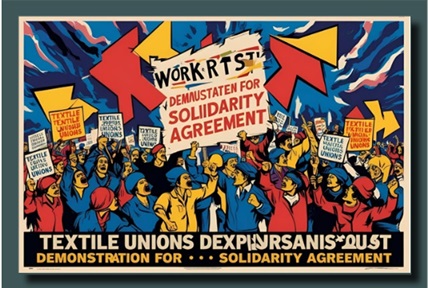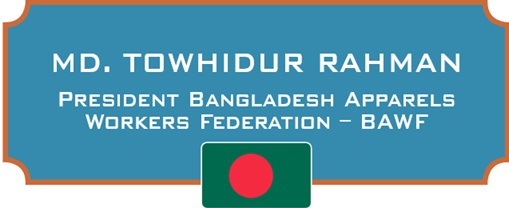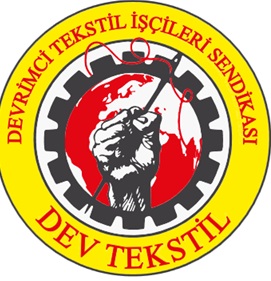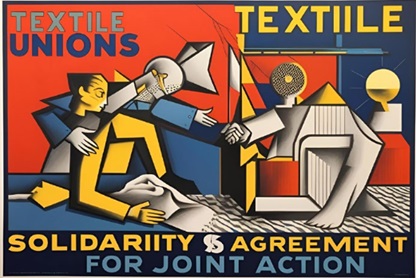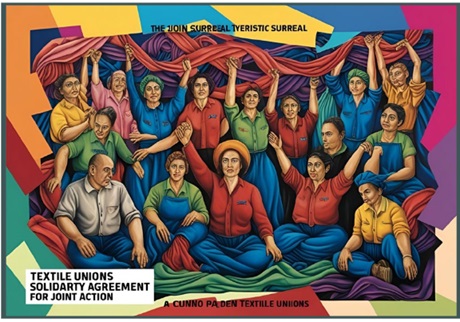rama kant RAI
Convener at National Coalition for Education New Delhi – INDIA
Education has been regarded as most important of the three constituents of UNDP’s Human Development Index (HDI), which measures the level of development of people living in the world. Educating people, particularly in elementary education is one very important development goal. The Indian constitution has provisions to ensure that the state provides education to all its citizens. The Indian constitution in its original enactment defined education as state subject. Under Article 42 of the constitution, an amendment was added in 1976 and education was transferred from state list to Central government. And education became a concurrent list subject which enables the central government to legislate it in the manner suited to it. Besides India is signatory to a number of international covenants i.e. Jomtien declaration, UNCRC, MDG goals, Dakar declaration SAARC SDG 2030 charter for children which is binding on its commitment for making education a reality for all children.
After the new economic policies initiated during India has witnessed a rapid increase in privatization within its education sector. Privatization and commercialization of education has taken a rapid growth across the country. In 2021-22, private unaided schools accounted for over 32 percent of total schools imparting education in India. In higher education, 67.51 percent of 1,385 universities and 37.81 percent of 60,127 colleges in India are private.
This trend towards privatization has been accompanied by commercialization, with education being seen as a lucrative business opportunity by investors and entrepreneurs. While privatization has expanded acCess to education, it has also raised concerns about commercialization, inequity, quality, and regulation.
During the year 2009 government of India amended its constitution (86 Amendment) which makes elementary education a fundamental right to every child between the age group of 6-14 years. This implies that the State must provide free and compulsory education to all the children of age 6-14 years. Earlier this was under the Directive Principles of State policy in the constitution, and the government was not obliged to the same. This new provision in the Constitution which has an indirect but significant bearing upon the role of the government of India in education is entry 20 of list III, which is concerned with “Economic and Social Planning”. Education planning being an essential element of economic and social planning, the government of India and the State Governments has to work together in preparing and implementing the national plans for the reconstruction of education.
Education Policies: The National Policy on Education (NPE) 1968 and the NPE 1986 have laid special emphasis on the fulfillment of the Constitutional Directive of universalization of elementary education (UEE).
The new Education Policy 2020 and its outcome:
The National Education Policy 2020 (NEP, 2020) came into being in 2020. The policy is is supposed to revamp the entire education system of India to make education for all a reality which would cater to almost 50 per cent of India’s population. The New Education Policy 2020 and Sustainable Development Goal 4 requires substantial government expenditure on education in a phased manner. The Interim Union Budget 2024-25 is the fourth budget after the rollout of the NEP 2020, where the education sector has received Rs 1,20,628 crore (see chart 1). This is equivalent to 0.37 per cent of the country’s GDP. During the first year of NEP implementation, the share was 0.43 per cent. (See chart 2 and 3). While the NEP aspired to achieve six per cent of GDP allocation to education, the declining share of the Ministry of Education (MoE)’s budget questions the government’s financial commitments towards NEP implementation.
A closer look at how this year’s budget has been designed reveals that 74 per cent of the budget of the Department of School Education & Literacy (DSEL) will be financed through an education Cess, of which 59 per cent will be met through a primary education Cess and 14 per cent through a secondary and higher secondary education Cess. Similarly, 33 per cent of the Department of Higher Education(DOHE)’s budget would be financed through an education Cess. A further disaggregated figure shows that 99.9 per cent of the budget of both Samagra Shiksha Abhiyan (SMSA) and Pradhan Mantri Poshan Shakti Nirman (PM-POSHAN earlier known as Mid-Day Meal programme) will be financed from the education Cess. The Cess was perceived to supplement the additional resource requirements for universalising school education. However, over me, it has become the primary source of financing school education.
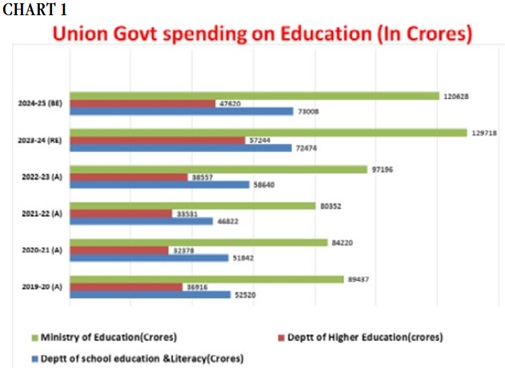

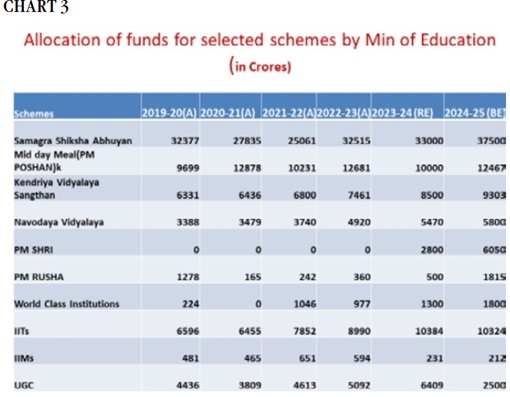
New education Policy 2020 Promotes Privatization:
- The policy talks about encouragement and facilitation of true philanthropic private and community participation in the name of public education system. The new suggested regulatory regime, with clear separations of roles and transparent self-disclosures, empowerment and autonomy to institutions, and the appointment of outstanding and qualified experts to leadership positions will help to enable a far smoother, quicker, and more transparent flow of funds.
- Policy talks about book promotion; means book publication and printing business goes to private hands
- An effective quality self-regulation or accreditation system will be instituted for all stages of education including pre-school education – private, public, and philanthropic – to ensure compliance with essential quality standards.
- States/UTs will set up an independent, statewide, body called the State School Standards Authority (SSSA). The SSSA will establish a minimal set of standards based on basic parameters (namely, safety, security, basic infrastructure, number of teachers across subjects and grades, financial probity, and sound proCesses of governance), which shall be followed by all schools.
Funding: 6% of GDP for education as the earliest???
The policy says to invest 6% of GDP at the earliest. In earlier draft policy at least there was declaration to invest 20% of budget within 10 years period. Now this policy is vague on this commitment. All it is talking about inviting philanthropic private actors to invest in education. Policy says efficient mechanism will be ensured for the optimal allocation and utilization of funds earmarked for SEDGs.
- Free school infrastructure can be used as “Samajik Chetna Kendra”.
We fear that such Kendra might get converted to some unacceptable religious preaching kendras.
The Public Private Partnership:
Ministry of Human Resource development, Government of India had issued a concept note for launching privatization of education in the name of so called “Public Private Partnership (PPP) <dirsch1.edu@nic.in>. Government is convinced that there is an urgent need for replacement of bureaucratic controls in education by professional regulations along with private-public partnership to ensure universal primary education. Competition in tertiary and secondary education is also equally essential. To attain financial independence (from external assistance), the government imposed a 2 percent Cess on all central taxes.
The question arises, if government is going to provide Free and Compulsory Education to every child where does the question of affordability arise? It in itself indicates the government’s intention of privatization of school education.
In its recent move for Public Private Partnership (PPP) government of India, Ministry of Human Resource Development has floated a concept of inviting private sector in the name of ‘Public Private Partnership’. This move is based on certain assumptions; one Ministry of HRD is encouraged by a World Bank Research study”. Public Private Secondary Education for Developed countries – a comparative study” The study presents inferences on cost and achievement of performance in public and private schools in five developing countries i.e. Columbia, Dominican Republic, Philippines, Tanzania and Thailand. The study concludes that;
- Students in private schools outperformed students in public schools on a variety of achievements.
- Unit costs of private schools were lower than those of public schools and
- Private schools had greater authority for decision making at the school level and better emphasis on enhancing student achievement.
On the basis of these findings the government of India is encouraged to take it as a solution of budget crises in India and an effective measure for universalization of elementary education for all. Government is keen to invite public private partnership in three areas i.e. (1) Infrastructural development (2) Support services and (3) Educational service.
Government of India’s move in RTE Act 2009:
The latest Right of Children to Free and Compulsory Education Act 2009 proposes to establish a new form of PPP in education, requiring all private schools to give 25% of their places to government-paid students from disadvantaged homes. This measure does not propose to give money to the disadvantaged students to attend a school of their choice but rather proposes to give money directly to the private schools that accept the students.
Government of India intends to open its door for following services to the private partner under PPP contract provision:
(i) Infrastructure facility services (design, build and maintain school building)
(ii) Non-educational services (catering, transport of students etc)
(iii) Support services (IT facility, library, playfield, gymnasium etc)
(iv) Educational services
(v) Teachers’ training
(vi) Management of public schools (with the existing staff and facilities)
(vii) Operation of public schools (provision of teaching and non-teaching services including staff).
(viii) Provision of teaching services in private schools to publicly funded students
(School voucher system).
Model schools:
Government of India has proposed to set up 6000 model schools at the rate of one school per block. These schools will be centers of excellence and would have infrastructure and facilities at least of the standard of Kendriya Vidyalayas with stipulation for pupil-teacher ratio, educational environment, appropriate curriculum, and emphasis on output and outcome. About 3500 educationally backward blocks would have model schools that would be set up in the government. The remaining 2500 blocks would have model schools to be set up under PPP to be managed by the private partner with full autonomy and management control. The government would provide a capital incentive.
The critique:
In its concept note government of India gives following rationale for privatization of education:
There is huge gap of school infrastructure which government cannot fulfill due to lack of resources. By the involvement of private players, it will be easy for government to fulfill the resource requirements for school infrastructure and management.
Private sector has greater efficiency in certain areas because of specialization. The private sector staff is more accountable to their system.
Private sector involvement will share the risk which government alone happened to bear.
Speedy implementation: In government system timely implementation becomes difficult because of many players and decision process. There will be faster implementation of projects by the private partnership.
Cost reduction is another factor which government is convinced about. Government feels that private sector is more efficient in working and managerial efficiency hence there will be cost reduction in implementation of projects.
Performance accountability: Government feels that in government school’s performance accountability is quite defused. There will be greater accountability in private run schools because of performance based payment of grants.
Quality monitoring. Government will monitor the quality of private sector and payment will be made on the basis of quality performance. Private partners will incentivize the quality performance for getting the payments.
Greater flexibility: Under PPP there will be greater autonomy of private sector whereas in government schools there is greater rigidity. The private sector will have higher autonomy in hiring the teachers and organizing the schools. Similarly depending upon the need the schools’ processes can be modified quickly.
In the world over there are 138 countries who constitutionally guarantee the right to provide free and compulsory education to all its children. Only 46 countries do not guarantee it. However, they regulate the schooling and provide better monitoring and schooling facilities. Their performance in schooling is far better than India. India is still lagging behind many goals for education as mentioned in MDG, Dakar and in EFA goals.
It will not be a justification on part of government to say that, “there is huge gap of infrastructural facilities which government alone cannot fulfill”. Perhaps it will be a denial of fundamental rights of children. If government can realize the education Cess to a substantial percent of education budget and can be self dependent by saying ‘No’ to overseas aid. It should raise its resources for education especially elementary education.
It is unbelievable to read that private sector has greater specialization which government lacks. If the private sector has that kind of expertise the government still can hire it but not by privatizing the school education. We think government should promote expertise and specialization in its own system rather than looking at private sector.
Joint Risk sharing
The concept of joint risk sharing with private sector is nothing but a day dream. The earlier experiences indicate that it has been counter productive. Government cannot withdraw its responsibility by entrusting the task on private hands. Perhaps it will boost up corruption in education sector.
Speedy implementation: Why is there is no speedy implementation in government system? Speedy implementation in private partnership cannot overpower the bureaucratic hurdles. Otherwise private sector will go consequence free in implementation and it will be too late to take corrective action. This will all lead to deprivation of poor and marginalized classes from quality education.
Cost reduction: The other example of cost reduction is the case of ‘para teachers’ in government run elementary education. This is nothing but a compromise with quality education. Private players will not risk increasing their overhead to help the poor. Also why is there is a concern for cost reduction in education sector in the first place?
Performance Accountability: Why in the government system not accountable for its performance? And in private sector if an employee is accountable to its employer what are the binding factors? The recent liberalization in labour laws against workers have worsened the working conditions and leading towards unregulated private sector. The exploitation of teachers in private schools is well known and it should not be taken as a positive example.
Quality monitoring. Government is accepting the fact that it is not able to monitor its own schools for performance and quality. In the proposed Right of Children to free and compulsory education Act government is seeking civil society cooperation through SMCs for quality monitoring. That is a welcome initiative. By how come government will be more efficient in monitoring the quality performance in PPP system? It should rather strengthen its own monitoring system in government schools.
The induction of PPP will develop multi layered education system in India which will lead to inequality between rich and poor. This will be contrary to the concept of ‘Kothari Commission’ and the spirit of Indian constitution.
Greater flexibility: Government should induct more flexible mechanism in its own system. The autonomy of private schools leaves them unaccountable and the parents and children are the ones who suffer. Recent intervention by Hon’ble Supreme Court is an example of autonomy of private school’s governance.
Thus the private sector does not neCessarily reduce public financial burden, but also may enrich itself at government and social expense. That the PA schools survive only with public subsidies is an indisputable fact. In other words, an alarmingly disproportionate amount out of government expenditure on elementary education was spent on an infinitesimally small number of primary and upper primary schools. Similar is the situation in Tamil Nadu, though the degree of unevenness is not as sharp as in Uttar Pradesh. Thus, PA schools cause severe inequitable distribution of government expenditure on education.
Even in the ‘Right of children to free and compulsory education Act 2009 there is no mention of financial provision for realizing the right to education. The RtE Act 2009 should have provided a Financial Memorandum which should have indicated the exact amount of resources required for giving effect to the Bill. There is a brief Financial Memorandum attached to which seems a non-serious statement. It states: “It is not possible to quantify the financial requirement on this account at this stage.” This shows the lethargic attitude of government.
Finally, we are of strong opinion that “Right of children to free and compulsory education” is a fundamental right and in India this should and must remain the state responsibility. In no case this should be left on private sector. Government must develop common school system for promoting equity and equality for all children without any discrimination on the basis of economic background, gender, caste, colour and place of origin. It is also important that the role of private sector under PPP (if at all it is inevitable) should be seen as a supplementary to that of the government and not as a substitute. The commitment of SDG 4 cannot be accomplished unless govt spends sufficient resources on education.
References
- Economic survey 2008-9 India website: http://indiabudget.nic.in
- Towards Faster and More Inclusive Growth, An Approach to the 11th Five Year Plan Planning Commission Government of India
- Tilak, JBG, Govinda R., India Education Report (book) CED documentation, New Delhi
- Sadgopal, Anil (2006a). Privatization of Education: An Agenda of the Global Market. Combat Law, 5(1), February-March, pp.22-27
- Times of India, Akshaya Mukul, TNN 29 September 2009, 02:41am NEW DELHI: Economic survey 2008-9 India website: http://indiabudget.nic.in
- Towards Faster and More Inclusive Growth, An Approach to the 11th Five Year Plan Planning Commission Government of India
- Primer on Budget Analysis, Taking case of elementary education CBGA, New Delhi 2007
- Public-Private Partnerships in Latin America: A Review Based on Four Case Studies, José-Ginés Mora, Technical University of Valencia, 2005
- Right of Children to Free and Compulsory Education Bill, 2009: The Story of a Missed Opportunity, Muchkund Dubey, Mainstream, Vol XLVII, No 40, September 19, 2009
- AcCess to and Privatisation of Education, Global Campaign for Education
- Combat Law Vol 8 issue 3 & 4 May Aug 2009 New Delhi
- OF MONIES AND MATTERS CBGA An Analysis of Interim Union Budget 2024-25.
- Public vs. Private: Understanding the Shifting Landscape of Indian Education; Privatization of Education in India by Prof. Arun C Mehta (2024)
*The author is Convener at National Coalition for Education New Delhi and can be contacted at +917011255324 cosar.lko@gmail.com





